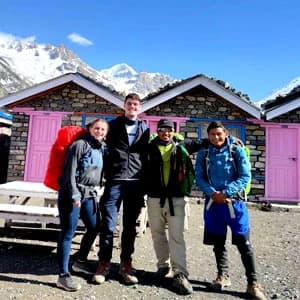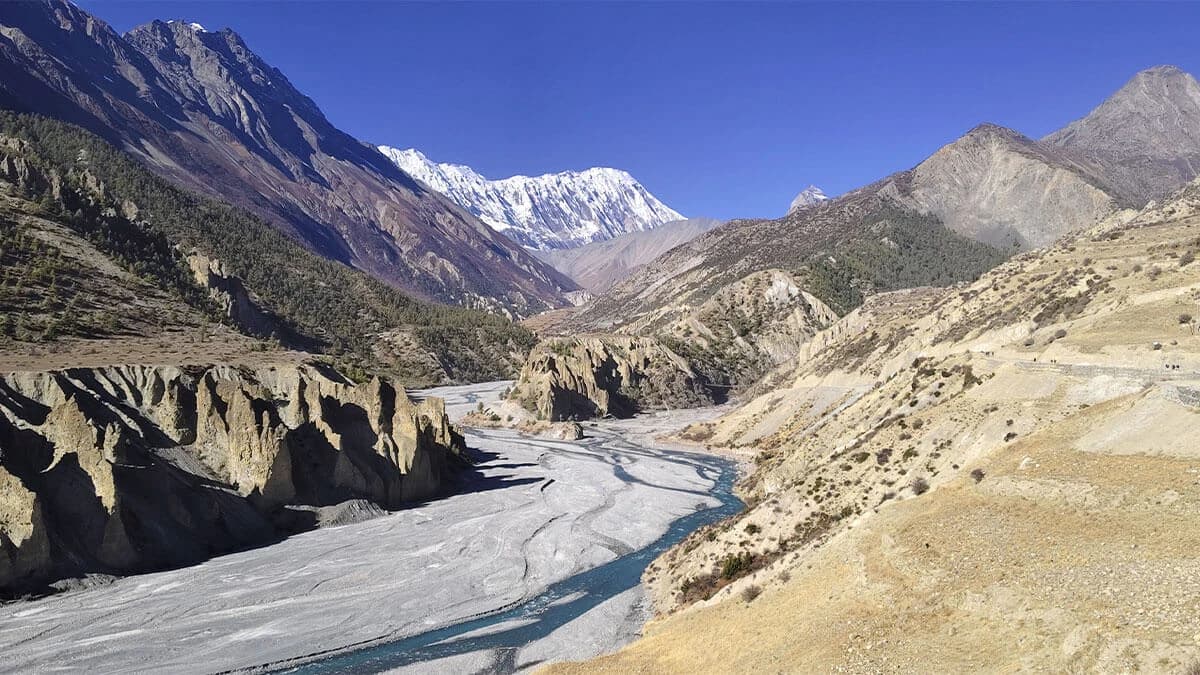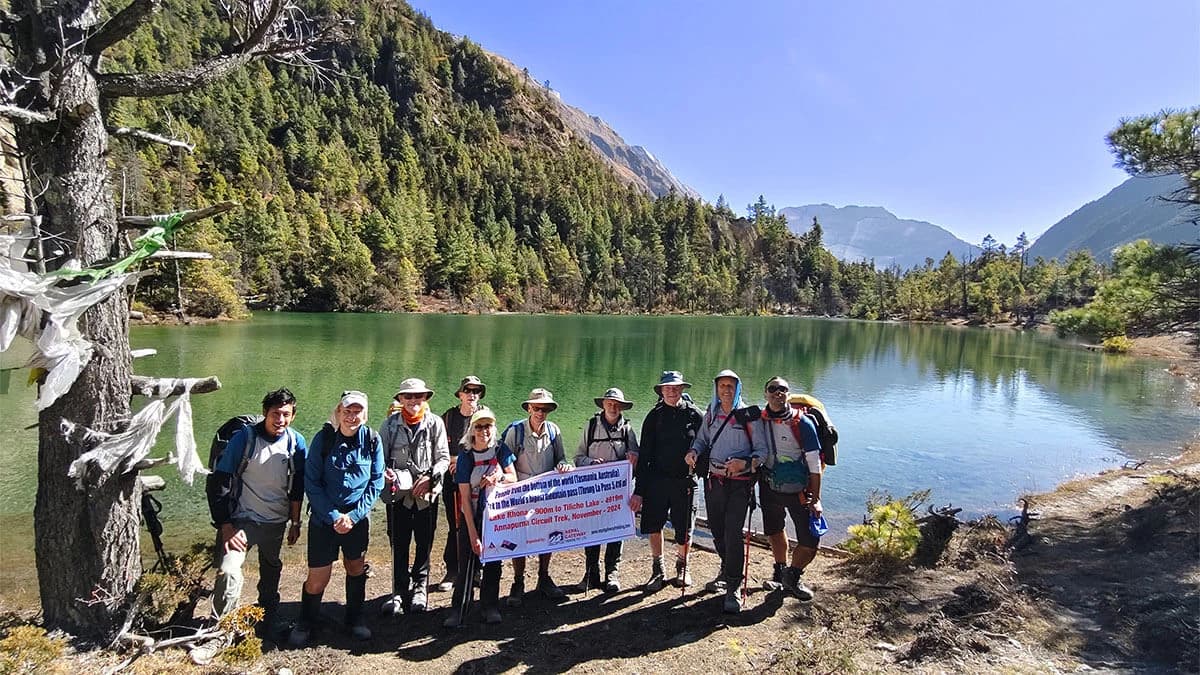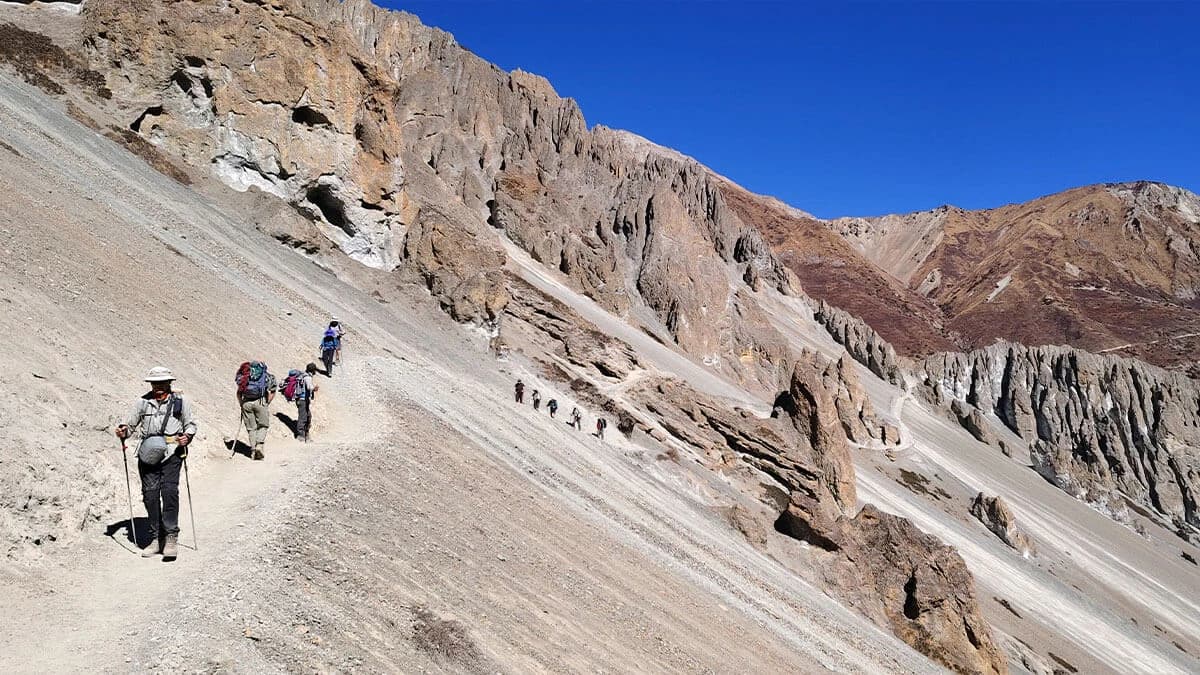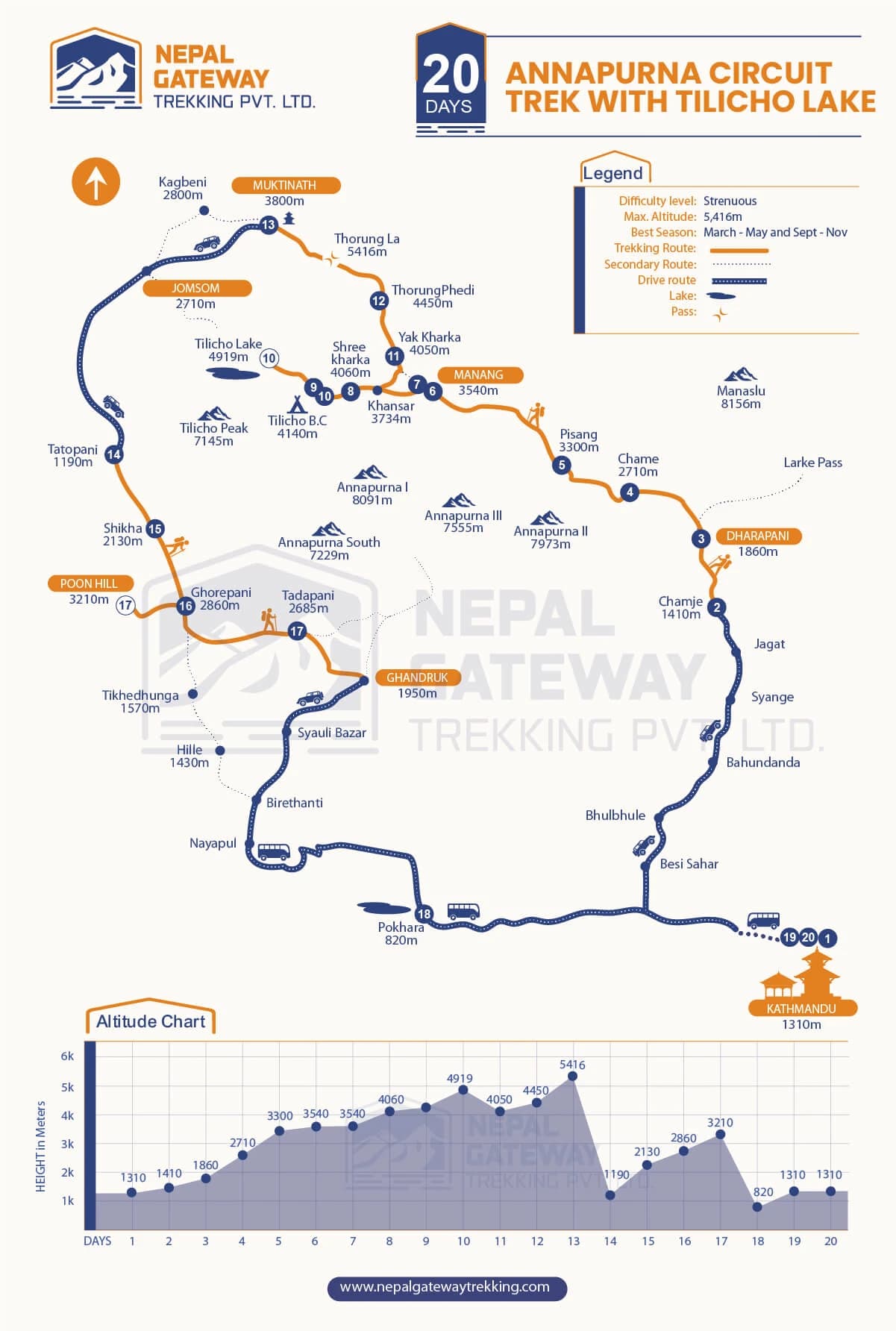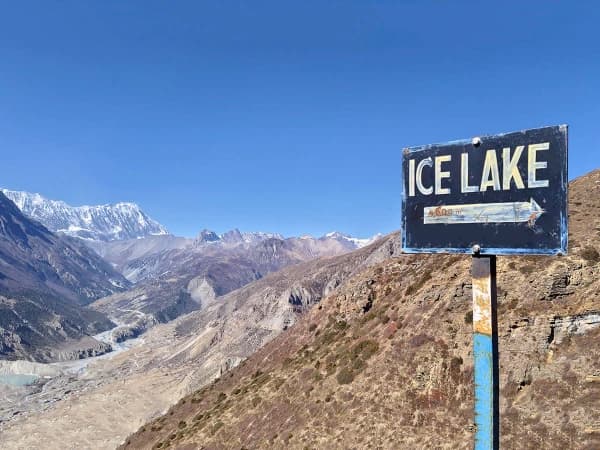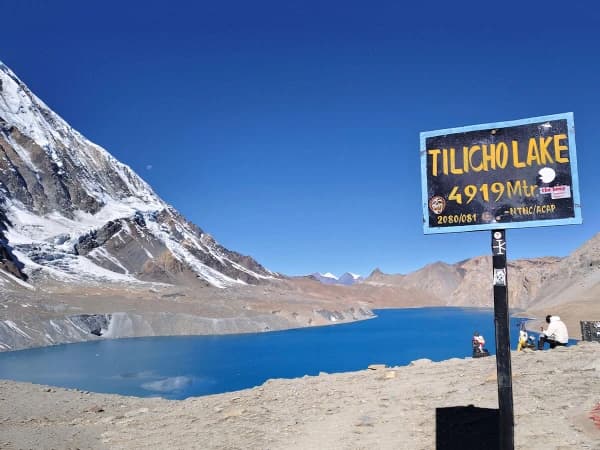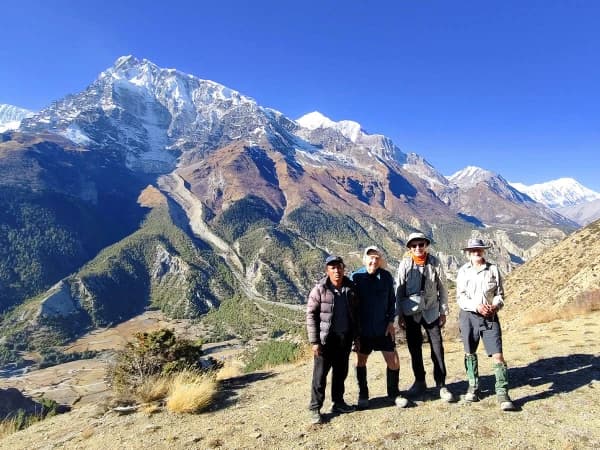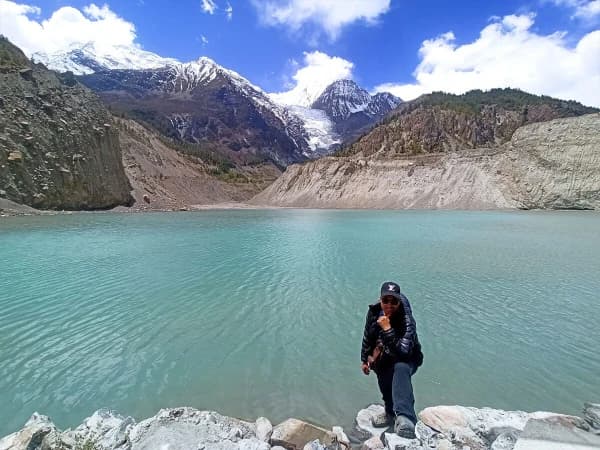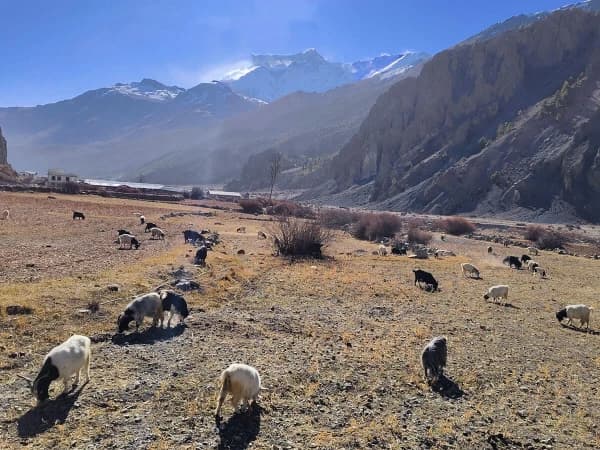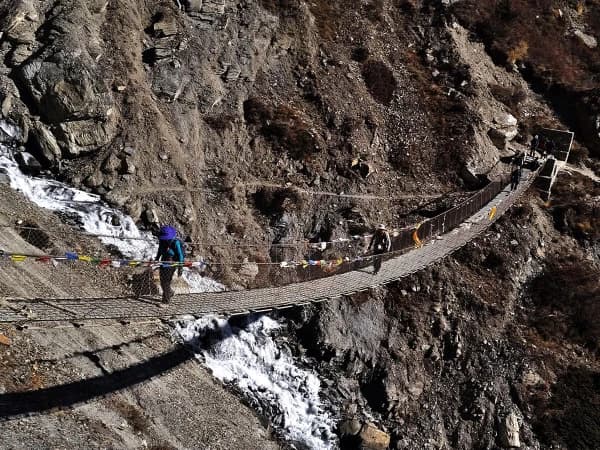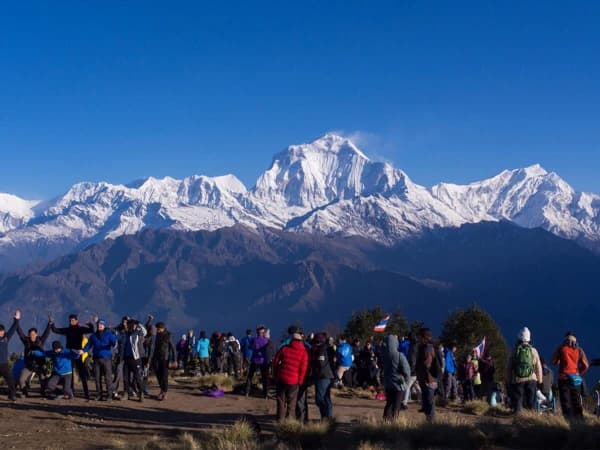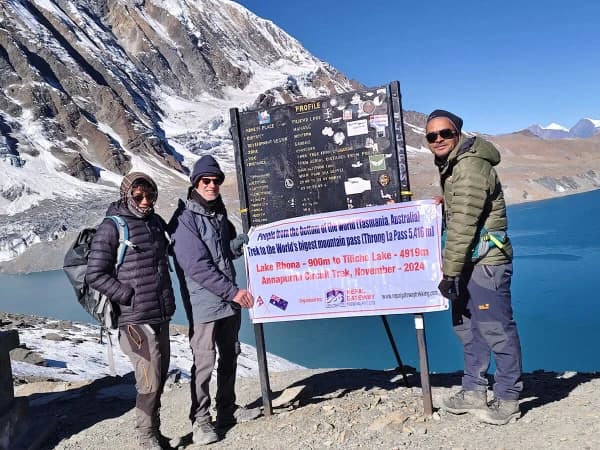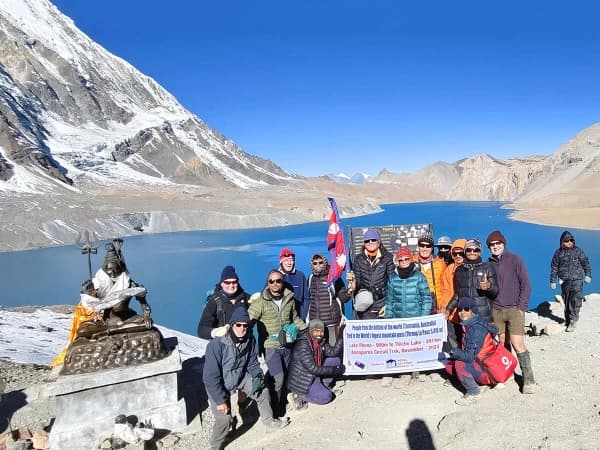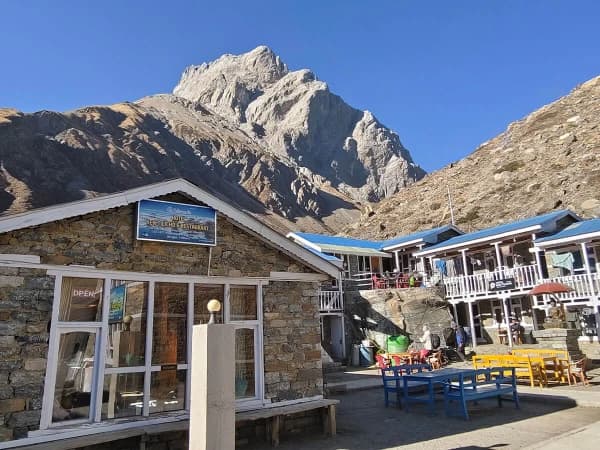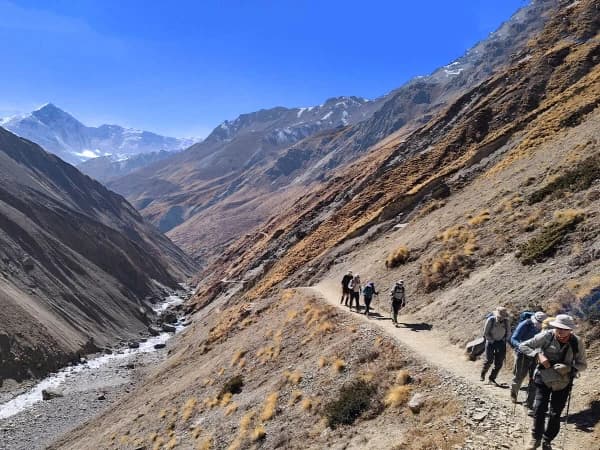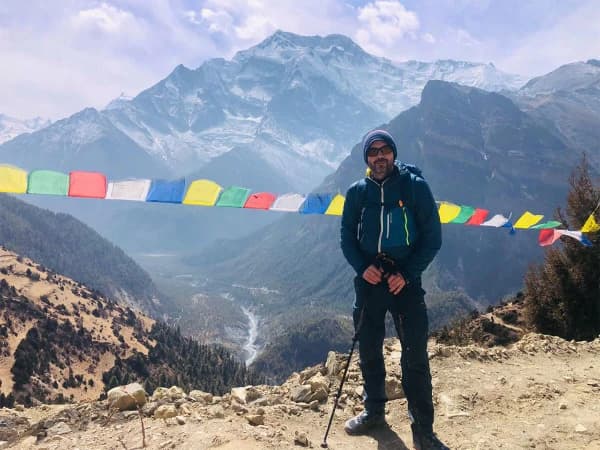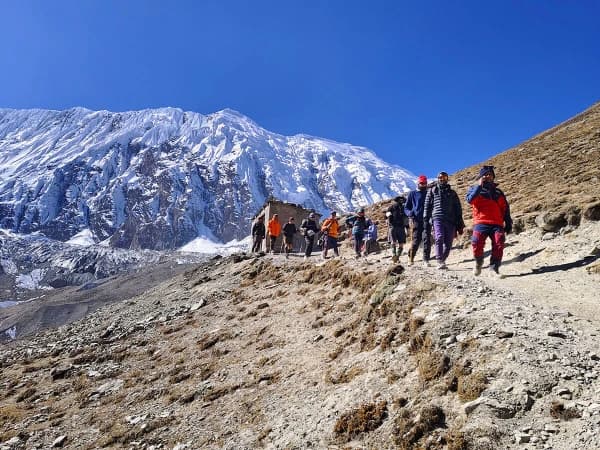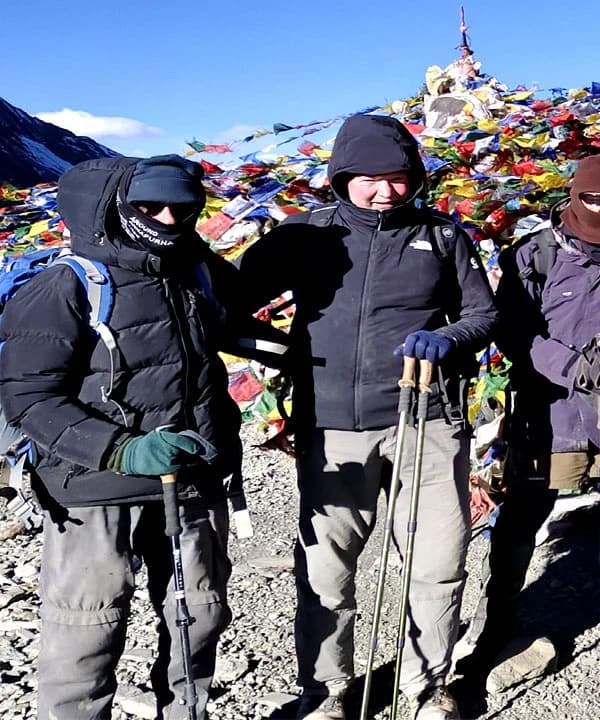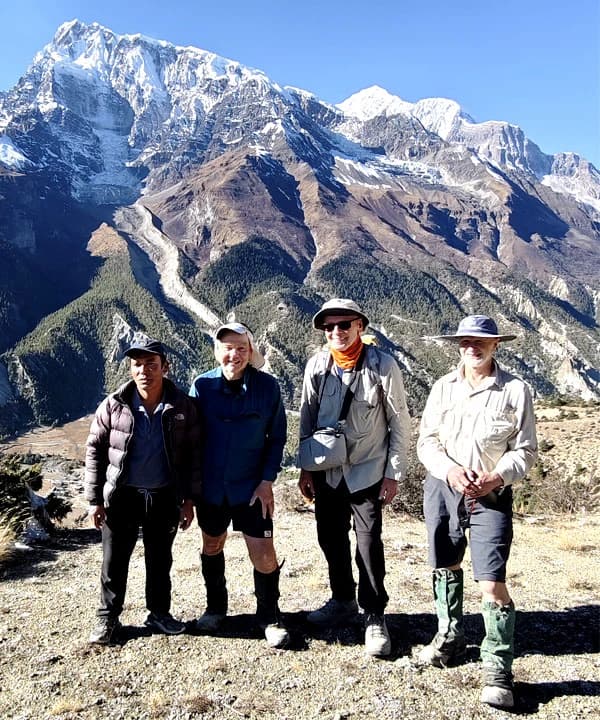Are you looking for an ultimate adventure in Nepal with visiting the highest lake and highest pass? Let you embark on the Annapurna Circuit Trek with Tilicho Lake for a life-changing adventure moment.
Annapurna Circuit Trek with Tilicho Lake
Annapurna Circuit Trek with Tilicho Lake in Nepal is the best ultimate adventure among other trekking trails. This ultimate adventure takes you to witness the highest lake in the world, Tilicho Lake, at 4,916 m, and cross over Thorong La Pass, at 5,416 m. The classic Annapurna Circuit Trek has long been considered one of the world’s most iconic walks.
Combining it with Tilicho Lake and Poon Hill takes the experience to a whole new level. This extended adventure offers the best experience of the Himalayas. You will experience jaw-dropping natural beauty, high mountain passes, and glacial lakes to spectacular mountain panoramas.
The story of the Annapurna Circuit begins on the ancient salt trade routes connecting Nepal with Tibet. Once travelled by pilgrims and salt traders, these trails now welcome thousands of travellers from around the globe.
The Annapurna Circuit Trek with Tilicho Lake showcases Nepal’s diverse landscapes and scenery. Starting at the subtropical lowlands of Besisahar (760 meters), the trail meanders through terraced fields. The cascading waterfalls, rustic villages, and high valleys lead to the glacial shores of Tilicho Lake (4,919 meters).
Then, across the formidable Thorong La Pass (5,416 meters) and descending through the Kali Gandaki Gorge. The trail once again enters the subtropical forests towards the viewpoint of Poon Hill (3,210 meters).
The Annapurna region is a cultural mosaic with diverse ethnicities, people, and lifestyles. The lower reaches predominantly house the Magar and Gurung communities, while the upper reaches reflect strong Tibetan influences among the Manangi and Thakali tribes.
The colorful prayer flags, mani walls, and ancient monasteries add a touch of cultural and spiritual experience. You’ll visit the centuries-old gompas at Braga and Manang to better understand the cultural and spiritual aspects. Moreover, you’ll take a holy bath at the 108 waterspouts of Muktinath Temple for spiritual purification.
As Nepal’s most significant protected region, the Annapurna Conservation Area (ACA) shelters wildlife. Langurs and barking deer are common breeds in the lower valleys. While pikas, musk deer, blue sheep, and snow leopards are rare possibilities in the upper reaches. You can also spot birds like the Himalayan monal, cheer pheasant, and Himalayan griffons in the skies of the Annapurna.
The Annapurna Circuit Trek with Tilicho Lake is a strenuous expedition best suited for seasoned trekkers and adventure enthusiasts. This is the best trek for those willing to immerse themselves in the Himalayas' raw nature, history, and culture.
The major highlights of the Annapurna Circuit Trek with Tilicho Lake
- Explore the Tibetan-influenced settlements of the Manang and Mustang valleys.
- Conquer the mighty Thorong La Pass at 5,416 meters.
- Explore the world’s highest lake—Tilicho Lake—at 4,919 meters.
- Visit the 600-year-old Braga Gompa and other cultural landmarks along the route.
- Relish the unparalleled views of Annapurna, Dhaulagiri, Manaslu, Hiunchuli, Gangapurna, and Machhapuchhre.
- Take an acclimatization hike to the glacial lake of Gangapurna.
- Visit the sacred pilgrimage site of Muktinath and bathe at the 108 waterspouts of “Mukti Dhara” for spiritual purification.
- Drive across the world’s deepest gorge—Kali Gandaki Gorge.
- Behold the 360-degree mountain panorama with a glorious sunrise from Poon Hill View Tower.
- Visit the old Gurung Museum in Ghandruk and immerse yourself in their authentic culture and centuries-old traditions.
- Explore the lake city of Pokhara and relax at the shore of Phewa Lake.
Route Overview of Annapurna Circuit Trekking with Tilicho Lake
The journey of the Annapurna Circuit Trek with Tilicho Lake set off with a long, scenic drive from Kathmandu to Chamje via Besisahar. At Chamje, you’ll be ready with your gear to begin the ultimate on-foot adventure in the Annapurna region. You will walk along the lush forests, picturesque waterfalls, terraced fields, and occasional suspension bridges.
The next few days of the trek take you through several enchanting villages, including Dharapani, Chame, and Pisang. As the trek ascends further from Pisang, the lush greenery transitions into an alpine wonderland. The trail unveils the majestic peaks of Annapurna, Manaslu, Pisang, and Gangapurna.
The acclimatization day at Manang provides an excellent opportunity for rest and recovery. You’ll have plenty of time to explore the valley and hike to Gangapurna Lake. Leaving Manang, you’ll momentarily diverge from the main Annapurna Circuit route and head towards Tilicho Lake.
From here, the trail becomes more rugged and strenuous. You’ll ascend through Shree Kharka and Tilicho Base Camp, reaching the world’s highest lake, Tilicho Lake, at 4,919 meters.
After an unforgettable time at Tilicho Lake, you’ll retrace the route to Shree Kharka via Tilicho Base Camp. From here, you’ll follow a shortcut route to Yak Kharka, rejoining the main Annapurna Circuit route.
The trek takes an adventurous tone as you climb to Thorong Phedi and cross the iconic Thorong La Pass, which is 5,416 meters high. The steep descent leads you to the holy site of Muktinath, where you’ll catch a local bus to Tatopani.
From here, the journey continues through the rhododendron forests towards Ghorepani via Shikha. The morning hike to Poon Hill rewards you with a jaw-dropping mountain panorama, glistening in the golden hue of sunrise. You’ll descend through the winding roads of Deurali and Tadapani to arrive at the traditional Gurung village of Ghandruk.
You’ll end the on-foot journey at Ghandruk and catch a local jeep to the bustling city of Pokhara. The following day, you’ll take a tourist bus from Pokhara to Kathmandu, where you’ll conclude your Annapurna Circuit Trek with Tilicho Lake.
Why the Annapurna Circuit Trek with Tilicho Lake with Nepal Gateway Trekking?
- Nepal Gateway Trekking proudly stands as one of the country’s leading trekking companies. Our team has been operating the Annapurna Circuit Trek with Tilicho Lake for over a decade, garnering in-depth knowledge about the region. Over the years, our team has refined the trek itinerary with great attention to providing our clients with the best mountain experience. Our thoughtfully planned trek package guarantees client satisfaction with an unforgettable adventure while also prioritizing their safety.
- Our company follows comprehensive safety standards with advanced first-aid kits, acclimatization days, and standby medical transport. Our guides and porters are trained in first aid, wilderness survival, and altitude sickness to provide critical first-aid treatment, assess health emergencies, and make prompt evacuation decisions.
- Our team provides all the necessary support and services to make your holiday hassle-free. We’ll handle the entire trek logistics, customize the itinerary according to your preferences, arrange transportation, and obtain all the permits required for the Annapurna Circuit Trek with Tilicho Lake.
- We make accommodation reservations months in advance to ensure a comfortable stay, even in the remote parts of the trek. This initiative helps to secure rooms in the best hotels and teahouses, avoiding last-minute hassles and overcrowding. Our package includes 3-star hotels in Kathmandu and Pokhara and local teahouse accommodations on the trek.
- Nepal Gateway Trekking provides a professional, English-speaking guide accompanied by experienced on-field staff on all our treks. We have categorized our guides based on the region so they have intimate knowledge of the area. This initiative ensures better route navigation and insightful briefings about the trails, mountains, culture, and wildlife.
- Responsible waste management and sustainable practices are integral to our company’s core values. Therefore, we provide annual training to our guides, porters, and company staff on responsible practices to follow the “Leave No Trace” principle. We are fully committed to reducing carbon footprints and single-use plastics to protect the environment for future generations.
- Our package offers exclusive freebies, including an official Nepal Gateway Trekking t-shirt and a duffle bag for each client.
Itinerary
This is our standard and recommended Annapurna Circuit Trek with Tilicho Lake itinerary.
Welcome to Kathmandu! Upon touchdown, a representative of Nepal Gateway Trekking will greet you at Tribhuvan International Airport. He will provide a hotel transfer and assist you with the check-in process.
After checking in, take time to unwind—freshen up, enjoy a hot shower, and recover from jet lag. If you arrive early, you may have a few extra hours in the afternoon to explore the city. We recommend checking out Kathmandu Durbar Square, where centuries-old structures, courtyards, temples, and architectural complexes still stand.
In the evening, you’ll have a short briefing at your hotel, where you’ll meet the CEO, guide, and fellow travelers. Your guide will discuss the days ahead, trail conditions, itinerary, trip highlights, challenges, and safety protocols. If you need to buy or rent anything for the trek, consult your guide to find reliable outdoor shops in Thamel.
Tips: We recommend you pack your bags before bed to avoid last-minute hassle the next morning.
The adventure begins with an early morning drive from Kathmandu to Chamje. Keep an eye out for captivating sceneries of lush valleys, terraced fields, countryside settlements, local bazaars, and roadside tea shops.
Upon reaching Dumre, you’ll leave the highway and take a narrow back road towards Besisahar. Driving past several villages, you’ll arrive at the bustling bazaar of Besisahar around 3 in the afternoon. Here, you’ll switch the ride to a local 4x4 jeep and head off for a thrilling off-road journey to Chamje.
It’ll be late by the time you reach Chamje. So, settle in the local teahouse for the night and enjoy their hot meal in the cold evening.
Note: Driving along the Prithvi Highway can be challenging for some travelers. Due to expansion work, the road remains in bad condition. Expect frequent undulating patches, bumpy sections, and occasional dust clouds along the route.
After a long, tiring drive yesterday, it is time to embark on the adventure on foot. The day is relatively strenuous, with countless staircases to climb and a long way to cover. You’ll start the day by crossing one of many steel suspension bridges over the Marshyangdi River.
The trail is rugged, rocky, and steep as you head towards the picturesque village of Tal. Nestled on the sandbank of the Marshyangdi River, this village is clustered with old local houses and well-facilitated teahouses. One noteworthy highlight of the valley is the large waterfall on the northern end, locally known as Kau Khola Waterfall.
Heading out of Tal, the walk continues on a relatively rugged, narrow trail carved out on the imposing rock walls along the riverbanks. Compared to the endless staircase climbing in the first half of the day, the climb from Tal to Dharapani is slow and gradual. You’ll arrive at Dharapani by lunchtime.
After enjoying a warm and delicious lunch at the teahouse, you can go for a short walk to the village of Thoche. This nearby settlement is where the routes of the Annapurna Circuit converge with the Manaslu Circuit.
After breakfast, the day begins with a gentle ascent on the broad, motorable road. After a short walk, you’ll reach the Buddhist village of Bagarchhap, where you’ll get the first glimpse of Annapurna II.
As you head out, you’ll ditch the motorable road and enter a narrow forested path. You’ll crisscross the steep stone stairs carved on the granite cliffs and head toward the village of Timang. On a clear day, you’ll get majestic views of Annapurna II, Manaslu, and Lamjung Himal from the village.
The rest of the walk from Timang to Chame follows the main road. Gradually meandering through the settlements of Tanchowk and Koto, you’ll reach the overnight destination around 2 PM.
Chame is the administrative headquarters of Manang district. This small town has teahouses, internet cafes, restaurants, trek-gear shops, local banks, and a health post. If you still have some energy, you can go to the natural hot spring on the other side of the river and immerse yourself in the warm water to relax your muscles and alleviate stress.
Your day begins with crossing a steel bridge over the Marshyangdi River. The portion beyond the bridge involves traveling on a dirt road. Although the road is unpaved and dusty, it is quite scenic as it meanders through a lush forest of blue pine and Himalayan spruce. Occasionally, the trail rewards you with views of Annapurna and Lamjung Himal from the small, sunlit clearings in the forest.
After a few hours, you’ll arrive at the tiny village of Bhratang. This village is well-known for its apple orchards and the delightful delicacies prepared from fresh, local apples. You’ll take a short break at Bhratang to visit its luxury agro-resort and enjoy the famous apple pie.
As you continue past Bhratang, you’ll be rewarded with the first glimpse of the soaring Paugda Danda (Sworgadwari). This massive, bare rockface towers over the distant landscape, curving gracefully like the edge of a bowl. You’ll cross a small bridge and continue to climb a zigzag road to the popular lunch spot of Dhukur Pokhari.
Walking past Dhukur Pokhari, you’ll reach an intersection that diverges the route to Lower Pisang and Upper Pisang. You’ll take the upper route and gently climb towards Upper Pisang for the night.
Note: Since you’ll spend the night at an altitude above 3,000 meters, you may, more or less, start to feel the effects of high altitude. Don’t worry—this is common! Make sure you take all the necessary precautions and drink plenty of hot fluid to keep your body warm and hydrated.
There are two routes to Manang from Upper Pisang on either side of the Marshyangdi River. The southern route is the easier option, involving a gentle drop to the Lower Pisang and continuing on the main road. The northern route is the more challenging option, requiring steep climbing along the forested trails of Ghyaru.
You’ll take the upper route to reward your effort with stunning mountain scenery. The day begins with a gentle walk toward the tranquil Green Lake. Soak in the lake’s calm atmosphere before continuing on a steep section toward Ghyaru. Nestled on a hilltop at 3,730 meters, the village offers a stunning view of Annapurna II, III, and IV.
From Ghyaru, the route gradually descends to the valley of Ngawal, where you’ll stop for lunch. After lunch, you’ll drop steeply to the valley floor and continue on the gentle road towards Braga. You’ll visit the 600-year-old Braga Gompa and soak in the cultural encounters of the region.
The walk from Braga is slow and short. It takes 20 to 30 minutes to reach the town of Manang. Clustered with big hotels, well-facilitated teahouses, restaurants, cafes, and local shops, Manang is one of the most bustling towns in the Annapurna region.
An off-day for rest and acclimatization at Manang. There are several hiking options near the town to keep you active all day long. Since this is your day to unwind and recharge, there is no pressure to wake up early. You can take your time, enjoy a relaxed morning, and settle in for breakfast at your own pace.
After breakfast, you’ll take a short hike to Gangapurna Lake. Nestled on the lap of Gangapurna Himal and Annapurna IV, this icy glacial lake offers a scenic view of Annapurna III, Pisang Peak, Chulu Peak, and Tilicho Peak. If you have a bit of energy left in your legs, you can hike to the viewpoint above Gangapurna Lake and enjoy the aerial view of the glacial lake.
In the afternoon, you’ll climb a small hilltop to the eastern side of the town to visit Praken Gompa. This Buddhist monastery is located on a rock cliff at 3,945 meters and offers a rewarding view of Gangapurna, Annapurna II, Tarke Kang, and Annapurna IV.
As the day comes to an end, you’ll return to the teahouse at Manang and settle in for the night.
After the rejuvenating rest day at Manang, continue the journey with a short and comfortable walk to Shree Kharka today. The day begins with a gentle climb on the main road, high above the Marsyangdi River.
As you head out of Manang and approach the Khangsar Khola Valley, the surrounding terrains become increasingly rocky and barren, leaving behind lush vegetation. Although the road is relatively gradual, it does involve a few steep sections. After about an hour and a half, you’ll arrive at the small settlement of Khangsar, surrounded by a few chalet-like homes and teahouses.
After Khangsar, the trail becomes relatively challenging, but the dramatic mountain panorama at the backdrop makes it worthwhile. You can relish the views of Gangapurna, Annapurna IV, Manaslu, and other surrounding peaks along the route. You’ll reach Shree Kharka by lunchtime.
Upon reaching Shree Kharka, settle into the teahouse and take time to restore your energy for the next day.
The day begins with a steep climb from Shree Kharka on a dusty, bare track towards Tilicho Base Camp. After a short while, you’ll arrive at an intersection where the old, rugged road diverges from the new, comfortable route. Take the new route and climb the high ridge, following the Marshyangdi River.
The trail to Tilicho Base Camp is quite scenic, with the views of Tilicho Peak, Khangsar Khang, and Idam Phra (a majestic rock formation) constantly adorning the surroundings. The final stretch of the day is a treacherous one! Regarded as the “Landslide Zone,” this section takes you across narrow, steep scree slopes, where small stones and rocks frequently fall from above.
As soon as you cross this section, you’ll arrive at Tilicho Base Camp. Settle in one of the teahouses for the night and rest through the entire evening.
Note: Since the base camp is located at 4,140 meters, it is common to feel the altitude. Do not panic! Stay calm, hydrated, and properly layered to prevent high-altitude sickness. If you notice any symptoms, inform your guide immediately!
On this day, you’ll hike to the world’s highest glacial lake—Tilicho Lake. You’ll begin the day early to avoid strong winds and unstable weather. The route to Tilicho Lake is relatively gradual, zigzagging through the landslide area. It takes around 3 hours to reach the lake from the base camp.
Relish the moment of pure tranquility as you arrive at Tilicho Lake. You’ll have plenty of time to soak in the mesmerizing scenery and capture a few photographs. After spending some time at the lake, you’ll retrace the route back to Tilicho Base Camp for an overnight stay.
Once you get to the teahouse, you can enjoy hot meals and relax for the rest of the day.
After breakfast, you’ll start the journey by retracing the route back to Shree Kharka from the base camp. The trail follows the narrow “Landslide Zone” along the scree slopes.
Once you arrive at Shree Kharka, you’ll take a shortcut route on the left side leading to Upper Khangsar. The climb is gentle, and the view of the surrounding peaks is breathtaking. There’s a viewpoint at Upper Khangsar, offering a distant view of the Marshyangdi River and Manang Valley.
From here, the trail descends steeply towards the valley floor of Yak Kharka. Reaching Yak Kharka means you’ve completed the Tilicho Trek and returned to the Annapurna Circuit Trek.
This day is relatively short and for all the right reasons. You’ll begin the day after breakfast with a gentle ascent towards Ledar. The route continues upwards to the top of a high ridge before dropping steeply to the river source of Marshyangdi.
You’ll cross a small wooden bridge and climb a steep hilltop alongside the river. You’ll likely start to feel the dry air, strong wind, and high altitude once you reach the top of the ridge.
From here, you’ll gradually descend on a treacherous, narrow path similar to that of Tilicho Base Camp, all the way to Thorong Phedi. When you get to the teahouse, take a much-needed rest and prepare for the big day tomorrow.
Today is one of the major highlights of the Annapurna Circuit Trek with Tilicho Lake. Today, you’ll wake up early, have breakfast, and start with packed lunch. The trail hits the road before dawn to avoid strong winds and mid-morning clouds at Thorong La Pass.
Heading out of Thorong Phedi, you’ll immediately find yourself climbing a steep zigzag uphill on a rocky path towards Thorong High Camp. Once you get past the High Camp, the trail becomes relatively gradual over a well-defined rocky ridge. It takes about 4 hours to reach the summit of Thorong La Pass.
Marked with colourful prayer flags and a rusty signboard, the summit offers a panoramic view of the Dhaulagiri and Annapurna ranges. You will see the peaks from the Annapurna, Dhaulagiri, Mustang, and Manaslu regions.
After spending some time at the top, the trail drops steeply on the other side towards the valley of Mustang. The downhill section, with slippery slopes along the moraine path, can get tricky. However, the close-range view of Dhaulagiri serves as a perfect distraction from the challenge.
After a long descent, you’ll leave the steep section behind and continue along the grassy slopes until you arrive at Muktinath. Before heading to the teahouse, you’ll visit the Muktinath Temple, a sacred pilgrimage place for Hindus and Buddhists, to soak in the cultural aspect of the trek.
Today will be a late start after a long day across Thorong La Pass the day before. After breakfast, you’ll head towards the bus station at the end of Muktinath and catch a local bus to Tatopani. The bus ride from Muktinath to Tatopani is truly an exhilarating experience.
First, you’ll drive through the gravel road to the village of Kagbeni, then follow the road along the Kali Gandaki Gorge. From here, you’ll continue to drive through Lower Mustang’s dusty and gravel roads. You will come across several local settlements, including Jomson, Marpha, Tukuche, Kalopani, Lete, and Ghasa.
It takes around 6 hours to arrive at Tatopani from Muktinath.
Heading out of Tatopani, the day begins with a routine stop at a tourist checkpoint to show your permits and register your details. After a few minutes, you’ll cross a suspension bridge over the Kali Gandaki River. From here, the trail climbs steeply over the stone stairs under the shades of dense forest.
You’ll reach the village of Ghara after nearly three hours from Tatopani, where you’ll stop for a short break. Although the day is challenging, the breathtaking sights of mountains in the distance and the wide-spread valleys below make it worth the challenge.
After a short break, you’ll continue climbing the staircases until you reach the overnight destination at Shikha. You’ll arrive at Shikha before lunchtime. Settle in one of the best teahouses in the village and enjoy the leisurely time for the rest of the afternoon.
This is a relatively short day on the Annapurna Circuit Trek with Tilicho Lake. The day begins with a gradual climb from Shikha through the terraced fields. The route alternates between dirt roads and stone-paved steps until you reach the village of Chitre.
Leaving Chitre, the path enters a dense Rhododendron forest and gradually becomes steep and strenuous. This section of the trek tends to come alive in spring, with red and pink rhododendrons adorning the entire surroundings. As you approach Ghorepani, the trail emerges from the trees and unfolds spectacular views of Annapurna and Dhaulagiri.
Ghorepani is a popular stop for trekkers heading to Poon Hill the following day. It is clustered with numerous teahouses, lodges, restaurants, cafes, and shops.
On this day, you’ll hit the road before the first light and hike towards the famous viewpoint of Poon Hill. The hour-long route from Ghorepani to the summit is a non-stop ascent.
From the top, you’ll get to relish the picture-perfect panorama of some of the world’s highest peaks, including Machhapuchhre, Dhaulagiri, Annapurna (I, II, III, IV, and South), Hiunchuli, and Lamjung Himal. Besides that, this viewpoint rewards you with one of the best sunrises of your lifetime, sparkling over the Himalayas.
After enjoying some unforgettable moments and taking a few photographs, you’ll trace the route back to Ghorepani. You’ll have enough time to pack your bags and enjoy a hearty breakfast here.
After breakfast, you’ll set off on a steep, challenging path towards Deurali Pass. Once you climb up and over the pass, the trail leads you through a series of ups and downs until you reach Tadapani to settle in for the night.
The walk from Tadapani to Ghandruk is relatively short and comfortable. After a hearty breakfast, you’ll begin the day with a gradual downhill on the stone-paved staircases.
Most of the day passes through beautiful rhododendron forests. The occasional tree openings offer a spectacular glimpse of Annapurna South, Hiunchuli, and Machhapuchhre. After an hour and a half, you’ll arrive at Baisi Khara—a small clearing amidst the dense forest with only a few teahouses.
After a short break, you’ll continue downhill along the forested trail until you arrive at the traditional village of Ghandruk.
You’ll have enough time to explore the village and visit the old Gurung Museum. The museum retains ancient artifacts, old photographs, traditional costumes, and historical relics. You can also wear the traditional Gurung dress at the museum, take a few pictures, and soak in the cultural experience of Ghandruk.
After a short exploration, you’ll stop at one of the many comfortable teahouses and enjoy the delicious Dal Bhat with the mountain views. After lunch, you’ll head towards the bus station and take a local jeep to Pokhara.
Once you reach Pokhara, you can take some time to shower, rest, relax, and eat at the hotel. In the evening, you can wander around the buzzing streets of Lakeside and spend some leisurely time at the shore of Phewa Lake.
After a hearty breakfast at the hotel, you’ll head towards the Tourist Bus Park in Pokhara to catch a bus to Kathmandu. Although the ride can often get exhausting, it is an excellent option to appreciate the natural scenery of the countryside and reflect on the days left behind.
You’ll reach Kathmandu by 3 in the afternoon. Your guide will transfer you to your respective hotel in Thamel and help you with the check-in formalities. Enjoy a hot shower at the hotel and let your body recover from the long, tiring drive.
In the evening, you can stroll around the bustling streets of Thamel, visit a local pub to enjoy live music, and buy souvenirs for family and friends at the local shops.
After a memorable 20-day journey to the Annapurna Circuit and Tilicho Lake, it is time to say goodbye! Start the day with a scrumptious buffet breakfast at the hotel. After breakfast, pack your bags and prepare the documents you need at the airport.
Our company representative will arrive at the hotel lobby three and a half hours before your flight. He will help you with the check-out procedure and provide a private transfer to the airport for your final departure.
We wish you a safe flight back home and look forward to seeing you soon. Until our next adventure!
Dates & Availability
Private tripCost Includes
- Complimentary airport pick-up and drop-off services.
- All ground transportation as per the program.
- Two nights' accommodation at a three-star hotel in Kathmandu, including breakfast.
- One night's accommodation at Hotel Splendid View in Pokhara, including breakfast.
- Your three meals (breakfast, lunch, and dinner) during the trek.
- Twin-sharing accommodations (a common bathroom) during the trekking.
- A highly experienced, well-trained government license holder English-speaking trekking guide.
- Required porters (1 porter between 2 trekkers). Porter is not included for solo trekkers.
- Annapurna Conservation Area Project permit. Please bring two passport-size photos for the permit.
- TIMS card (Trekkers Information Management System).
- Annapurna Circuit Trekking Map.
- Nepal Gateway Trekking Company T-Shirt.
- Nepal Gateway Trekking Company duffle bags for trekking.
- Local fresh fruits (oranges, bananas, apples, pears, and pomegranates) are served as a dessert after dinner.
- First aid kit with oximeter to check heartbeats and oxygen level regularly.
- All necessary government taxes.
- Office service charges.
Cost Excludes
- Lunches and dinners in Kathmandu and Pokhara.
- Travel insurance.
- International flight tickets to and from Kathmandu.
- Nepal Visa fees.
- All kinds of hot drinks (tea, coffee, and hot water) during the Tilicho Trek.
- Cold drinks (mineral water, Coke, and Fanta) and alcoholic beverages on the trek.
- Your first aid kit, equipment, and items of a personal nature.
- Hot shower and attached bathrooms.
- Battery charging for electronic devices and the internet.
- Snacks and desserts (apple pie, chocolate pie, chocolate bars).
- Tips for trekking staff and drivers. (Tipping is expected.).
- Extra accommodations in Kathmandu and Pokhara.
Good To Know
Annapurna Circuit Trek with Tilicho Lake Cost
The 20-day Annapurna Circuit Trek with Tilicho Lake costs USD 1350 per person. This package includes all the essential services—accommodation, transportation, meals, permits, etc.—to ensure a smooth and enjoyable trekking experience.
The standard package includes 3-star hotels in Kathmandu and Pokhara (BB basis) and mid-range teahouses during the trek. The hotels in Kathmandu and Pokhara are well-facilitated, and the teahouses provide limited facilities. In addition, the package cost includes local transportation to and from the trailheads.
However, you can upgrade your accommodation on the trek from mid-range teahouses to luxury lodges for an extra few hundred dollars. These luxury lodges include added amenities such as en-suite bathrooms, in-room charging facilities, heated blankets, and high-speed internet.
Likewise, you can upgrade your transportation from a public bus to a private car or commercial flight for more comfort. It’ll cost an extra USD 200 per person for a private vehicle and USD 200 to 250 per person for the flight option.
A major part of the cost goes to the guides, porters, and crew members. This includes their salary, accommodation, meals, transportation, daily allowance, insurance, and emergency support planning. As part of the package, we will also arrange the necessary permits for the Annapurna Circuit Trek with Tilicho Lake (ACAP and TIMS).
If you’re trekking with friends or family, you can enjoy group discounts ranging from USD 60 to 120 per person, depending on the group size. Contact us today to customize your trek and include necessary upgrades tailored to your preferences!
Best Time for Annapurna Circuit Trek with Tilicho Lake
Autumn (September to November)
If the Annapurna Circuit Trek with Tilicho Lake had a peak performance season, it would undoubtedly be autumn. The trails are in their best condition as the monsoon rain washes the dirt and debris away. The weather is usually dry and stable, with warm days and cool nights.
During autumn, the air has a different crispness, and the skies breathe a beautiful shade of blue. Besides that, the mountains are at their absolute best, offering unobstructed views of peaks from the Annapurna, Dhaulagiri, and Manaslu ranges.
However, popularity attracts crowds. Teahouses fill up quickly, especially in the upper regions, such as Shree Kharka, Tilicho Base Camp, Yak Kharka, and Thorong Phedi. So, we recommend booking ahead or starting your day early to ensure you don’t miss out on rooms.
Pro Tip: Consider doing the Annapurna Circuit Trek with Tilicho Lake in late September or mid-November to avoid the peak crowds while still enjoying the best of autumn.
Spring (March to May)
Spring breathes a different life into the Annapurna region, painting the entire trails with rich hues of rhododendrons, orchids, and other wildflowers. This is a season of rebirth, where the mountains echo with liveliness and the biodiversity with vibrancy.
Spring mornings are usually warm and visible in the lower altitudes, while afternoons bring thick cloud cover. The weather in the higher altitudes often remains warm, and the skies remain clear, offering breathtaking views of the mountains.
This is the second busiest season for Annapurna Circuit Trek with Tilicho Lake after autumn. Although less crowded than autumn, you should still be prepared for crammed trails and teahouses. Additionally, the weather in spring can change rapidly, especially in early March.
Pro Tip: April is the sweet spot for spring. It offers the perfect balance of stable weather, clear skies, blooming landscapes, and fewer crowds.
Winter (December to February)
Winter offers a remarkable experience for those seeking solitude and raw beauty. The cold, crisp air and snow-covered trails add an adrenaline rush to every step. The trails are often quiet, with only a few determined trekkers making their way to the Annapurna region. Hence, it is the best time to spot rare wildlife, including Himalayan Tahr, musk deer, and snow leopards.
Although the daytime temperatures are tolerable, the days are relatively shorter. The nighttime temperature can drop below 20°C, especially above 3,000 meters. Winter can often bring extreme weather conditions, frequent snowfalls, and even snowstorms at high altitudes. The trails to Tilicho Lake and Thorong La Pass can be covered in thick snow, sometimes making it impassable.
Moreover, the risk of altitude sickness, hypothermia, and snow blindness is relatively higher during winter. Hence, this season is not recommended for beginners.
Pro Tip: Layer up! We recommend investing in high-quality thermal clothing, sleeping bags, down jackets, and waterproof boots. Additionally, you should check weather updates frequently.
Monsoon (June to August)
During the monsoon, the arid landscapes of the Annapurna region transform into a lush, green paradise. The trails are usually empty, with only a handful of determined trekkers taking the risk.
Hence, the monsoon season offers a rare opportunity to experience solitude and calmness along the trail. Fewer trekkers also enhance cultural encounters, making the experience more personal with the locals. If you schedule the trip at the right time, you can also witness the Grand Yartung Festival in Manang and Mustang regions.
However, the monsoon season brings constant downpours, making the trail slippery and prone to landslides. The skies are usually cloudy, obscuring the mountain views. Additionally, the leeches tend to thrive in wet conditions, so be prepared to deal with them!
Pro Tip: Pack high-quality waterproof gear, dry bag, and bug repellent.
Annapurna Circuit Trekking with Tilicho Lake Permit
You’ll need two permits for the Annapurna Circuit Trek with Tilicho Lake. One is the Trekkers’ Information Management System (TIMS) and the Annapurna Conservation Area Project (ACAP).
Trekkers’ Information Management System (TIMS)
The TIMS Card, issued by the Nepal Tourism Board (NTB) and TAAN, is a mandatory trekking permit introduced to help authorities regulate trekking operations and track visitors along the route. It ensures the safety of the trekkers and manages their flow.
Cost: NPR 2,000 for foreigners; NPR 1,000 for SAARC nationals.
Where to get it: Nepal Tourism Board (NTB) or TAAN in Kathmandu.
Annapurna Conservation Area Project (ACAP)
The ACAP is a park entry permit that allows visitors into the Annapurna Conservation Area (ACA). The permit fees help support conservation, tourism suitability, and local infrastructure development.
Cost: NPR 3,000 for foreigners; NPR 1,000 for SAARC nationals.
Where to get it: Nepal Tourism Board (NTB) office or the entry gate at Besisahar.
How difficult is the Annapurna Circuit Trek with Tilicho Lake?
The Annapurna Circuit Trek with Tilicho Lake is a strenuous journey due to its remote location, rugged terrain, and high-altitude trails. While the trek does not involve technical climbing in any section, the route involves narrow ridges, steep ascends, rocky paths, and glacial moraines.
It requires walking 5 to 7 hours, with an average daily ascent of 600 meters. This demands a decent level of physical fitness and endurance. While the initial days include gradual and manageable walks, the steep and high-altitude sections above Manang bring a grueling challenge.
Over the course of 20 days, you’ll spend nine consecutive nights above 3,000 meters. The oxygen levels and air pressure drop significantly at such elevation, increasing the risk of altitude sickness.
The most challenging section of the trek is crossing Thorong La Pass at 5,416 meters. This high mountain pass includes a steep and rocky climb to the summit via High Camp. After crossing over, you’ll have to deal with the steep, knee-breaking descents towards Muktinath. You’ll also visit the world’s highest lake—Tilicho Lake—at 4,919 meters.
If you plan to trek in winter, you’ll have to prepare for extra setbacks. During this time of the year, the upper sections of the Annapurna Circuit and Tilicho Lake can become treacherous due to extreme cold, strong winds, heavy snowfall, and occasional snowstorms.
Training for Annapurna Circuit Trek with Tilicho Lake
The Annapurna Circuit Trek with Tilicho Lake demands meticulous preparation to ensure a safe and enjoyable expedition. Its high altitude, challenging terrain, and long-day trekking require solid physical fitness, mental resilience, and a structured training plan.
Conditioning Hikes
The best way to prepare for the Annapurna Circuit Trek with Tilicho Lake is to practice hiking on terrain similar to the trek. Look for hiking trails with uneven paths and elevation gains around your hometown, and make a habit of hiking.
We recommend starting with short 3 to 5 kilometer hikes with a small weighted pack. Once you get used to it, you can increase the distance, intensity, and weight. For proper adaptability, aim for weekly or bi-weekly hikes. If there are no decent hiking trails nearby, you can simulate the physical needs of the trek by climbing up and down the home stairs with a weighted pack.
Cardio Training
The Annapurna Circuit Trek with Tilicho Lake is a strenuous, high-altitude trek that requires decent lung capacity and overall endurance. That’s where cardio workouts come in handy! They are quite effective for building stamina, improving heart health, and enhancing the body’s ability to cope with reduced oxygen at high elevations.
Therefore, we recommend incorporating four to five steady-state cardio exercise sessions into your training regimen. These sessions can be as simple as brisk walking, cycling, swimming, running, or jump roping. Start with 30-minute workouts and gradually progress to more intense, hour-long sessions.
Strength Training
You must have strong legs, a core, and an upper body to comfortably do the Annapurna Circuit Trek with Tilicho Lake. Building strength in these areas helps to improve your body stability, refine balance, and prevent fatigue while trekking.
- Leg Strength: To strengthen your legs for steep sections and uneven terrain, we recommend adding exercises like squats, step-ups, calf raises, and lunges to your training routine.
- Core Strength: Workouts like Russian twists, leg raises, deadlifts, and planks help improve your muscles and body posture to carry a backpack.
- Upper Body Strength: Add exercises like push-ups, pull-ups, and shoulder presses to stabilize and strengthen your upper body so you can easily carry your backpack over long distances.
You should add three to four sessions of strength training to your routine. For each exercise, we recommend doing three sets of 15 to 20 repetitions.
Stretching and Flexibility
Navigating the uneven trails of Annapurna Circuit and Tilicho Lake requires good flexibility and joint mobility. To prepare your body for the trek, you should add a few dynamic stretches, yoga, and balance exercises.
Dynamic stretches and flexibility exercises improve blood circulation, build speed and agility, and boost muscle recovery. Therefore, you should add at least four sessions of these workouts, such as pigeon poses, hamstring stretches, single-leg stands, leg swings, and side stepovers.
Altitude Preparation
Training for high altitude can be challenging as you can’t replicate high-altitude conditions unless you live near the mountains. However, you can improve your body’s ability to adapt to such situations by practicing breathing techniques and aerobic workouts.
Aerobic workouts help your body cope with long days of walking, and deep breathing exercises optimize your oxygen intake. Besides that, we recommend spending a few days at moderate altitudes (around Kathmandu) before starting the trek to acclimate gradually.
Rest and Recovery
We cannot stress this enough! Most people often neglect rest and recovery. However, it is just as essential to your body as any other physical training. The more you work out, the more time your body needs to self-repair, self-heal, and self-strengthen.
So, consider taking some days off from heavy activities and just relaxing! On the day of rest and recovery, you can indulge in light activities such as walking, yoga, or even meditation to keep you focused. Additionally, we recommend prioritizing 7+ hours of sound sleep and following a balanced diet to fuel your training and recovery.
Acclimatization and Safety
Annapurna Circuit Trek with Tilicho Lake takes you through the high Himalayas of Nepal, where you’ll spend consecutive nights above 3,000 meters. Besides that, you’ll reach 4,919 meters at Tilicho Lake and 5,416 meters at Thorong La Pass. But with great heights come great challenges!
Acute mountain sickness (AMS) becomes a genuine concern above 3,000 meters. At this elevation, almost every trekker will likely experience mild symptoms like headache, shortness of breath, or difficulty sleeping.
But don’t worry! You can minimize the risks with proper preparation and acclimatization. Here’s how you can keep yourself safe and comfortable at high altitudes:
Things You Should Do to Acclimatize
- Take It Slow And Steady: This trek isn’t a sprint race—it’s more like a marathon. So, take your time, walk at a comfortable pace, and allow your body to acclimate to the increasing elevation naturally.
- Hydration Is Key: We can not stress this enough! Drink at least 3 liters of fluids every day and keep yourself hydrated. If drinking 3 liters of water every day seems a lot, supplement it with hot tea, soup, and lentils.
- Pack Light, But Pack Smart: Keeping your body warm, dry, and protected is crucial, especially at high altitudes. So, pack your bags for the right season. Some essentials include a down jacket, windbreaker, waterproof jacket, and hiking boots.
- Limit Your Daily Altitude Gain: As a rule of thumb, you should not exceed an altitude gain of 500 meters per day. Try to follow this rule whenever possible. On shorter days, go for evening hikes to a slightly higher elevation to help your body acclimate faster.
- Utilize Acclimatization Day In Manang: Make the most of acclimatization day with short hikes around the valley to stay active and adjust your body to the thin air. You should also make time to rest and recover for the days ahead.
- Avoid Alcohol And Other Stimulants: Alcohol, caffeine, and other stimulants are known to affect blood pressure, increase heart rate, and worsen dehydration. We recommend staying clear of these substances throughout the trek and keeping your body in full control.
- Eat Well, Even If You Don’t Feel Hungry: Although it is common to lose appetite at high elevations, your body needs proper nutrition. So, consume calorie-rich meals every day and keep your favorite snacks within reach to fuel your body in small breaks.
- Communicate Symptoms Immediately: Remember that acute mountain sickness usually begins with mild symptoms. If you notice any symptoms, no matter how mild, inform your guide or crew member immediately. Early detection and quick action can prevent the condition from worsening and save your entire trek.
Accommodation
Kathmandu and Pokhara offer accommodation options for every budget. Our package includes accommodations in comfortable 3-star hotels in the vibrant streets of Thamel in Kathmandu. We include a standard-category hotel at Lakeside in Pokhara.
These luxury hotels offer top-notch amenities, including air-conditioned rooms and en-suite bathrooms. You will get solar-heated hot showers, satellite TV, and Wi-Fi.
While on the trek, you’ll spend every night in the local trekking lodges or teahouses. Compared to other high-altitude treks, the teahouses in the Annapurna Circuit and Tilicho Lake are well-established. The teahouses are somewhat extravagant at lower altitudes, offering a wide range of rooms with en-suite bathrooms. In recent years, many new teahouses have been built in the region with pavement cafes, large dining areas, and sunrooms.
At higher altitudes, the teahouses usually have dorm-style rooms or basic cell rooms separated with plywood. These rooms include twin or triple beds, foam mattresses, mink blankets, and cotton pillows. Bathrooms are often shared in the upper regions.
The teahouses do not provide in-room heating facilities. However, they have a cozy communal dining area, often set around a stove-heated or yak-dung fireplace. The dining rooms are usually the most happening spots, packed with trekkers gathered for relaxation, meals, and socializing.
Note: The rooms in all accommodations (including Kathmandu, Pokhara, and during the trek) are twin-shared. If you prefer to stay alone without sharing the rooms, we can arrange a single supplement for an additional cost. However, this arrangement may not be possible in the upper section during peak seasons due to the limited number of teahouses and excessive demand.
Meals
The Annapurna region has a reputation for serving delicious food compared to other trekking areas. You can expect a wide range of food options in the Annapurna trekking route. Teahouses usually combine Nepali, Tibetan, and Indian influences with specialities from several ethnic groups. Moreover, this region offers an extensive range of foreign cuisines.
Teahouses commonly serve carb-heavy foods such as dal bhat, noodles, potatoes, pasta, momo, chowmein, thukpa, and spring rolls. Dal bhat is a staple in many teahouses because it is filling and offers free refills.
A few cafes and bakeries in towns like Bhratang, Ngawal, Manang, and Muktinath specialize in apple pies. Besides these items, you will get other baked goods, such as bread, cookies, rolls, and doughnuts. Most cafes in these towns also serve espresso coffee.
The menu also has a variety of beverages, including teas. You will get milk, black, masala, ginger, and lemon teas. You will get instant coffee, soft drinks, hot juice, hot chocolate, hot lemon, and bottled water.
Drinking Water
The teahouses in Annapurna Circuit and Tilicho Lake generally provide tap and boiled water. The locals often drink directly from the tap and claim it is safe to drink from the source. However, we do not recommend doing so. Untreated and unfiltered water is the number one cause of diarrhoea while trekking in the Himalayas.
Therefore, we recommend buying a reusable water bottle with a straw filter to remove bacteria, protozoa, and microplastics from the tap water. Additionally, you should carry chlorine or iodine-based water purification tablets or drops to purify the water for extra safety.
If you prefer to drink boiled water, the teahouses often charge a nominal fee on a per-cup or per-pot basis for boiled drinking water. Bottled water is available in almost every teahouse and local shop in the Annapurna region. However, we recommend not buying bottled water to minimize plastic waste in remote areas and promote sustainability.
Hot Shower
Hot showers are available in almost all teahouses in the Annapurna Circuit and Tilicho Lake. Most teahouses at lower altitudes (from Chamje to Manang) now have en-suite bathrooms with gas—or solar-powered hot showers.
As you trek to higher altitudes, the teahouses often provide shared bathrooms. Due to the region’s remoteness, running hot water is usually unavailable. Instead, the teahouse owners will give a bucket of stove-heated water for hot showers. The cost of a hot shower along the Annapurna Circuit and Tilicho Lake can range from USD 5 to USD 10.
Electricity
Electricity is available in almost every teahouse along the route of Annapurna Circuit and Tilicho Lake. In the lower regions, most teahouses have charging sockets in the rooms so you can plug your mobile phone, camera, and other electronic devices without extra hassle.
However, at higher altitudes, teahouses rely on solar panels for electricity, which means power is limited. Instead of in-room sockets, teahouses usually have shared charging stations in the dining or reception area. During the busy seasons, these charging stations can get crowded.
While most teahouses in the lower regions provide free charging, you’ll have to pay a nominal fee of USD 2 to USD 3 to charge your phone and camera. Although the entire trek has access to electricity, we recommend not relying solely on it, as bad weather and technical issues can often disrupt it.
It is best to carry high-capacity alternative power sources, such as power banks or solar chargers. These small devices can be lifesavers, keeping your phone and camera ready for incredible shots.
Mobile Network and Internet Connectivity
Mobile network coverage on the Annapurna Circuit and Tilicho Lake is surprisingly good compared to other trekking regions in Nepal. Both Nepal Telecom (NTC) and Ncell provide decent coverage across most of the trail. Only a few remote settlements at higher altitudes experience weak or no signal.
In case of emergencies, some teahouses in the Annapurna region also offer satellite phone service for an additional charge. For mobile data, you can expect 3G service in the lower section of the trek. However, as you ascend higher to the remote settlements, the connectivity becomes limited or unavailable.
Wi-Fi is widely available at the teahouses and restaurants along the trail. The teahouses in the lower section may include Wi-Fi in their room rates. However, in the upper section, the teahouses charge a small fee of USD 2 to USD 5 per device.
ATMs and Money Exchange
Always carry cash for extra expenses on the trek. Although a few teahouses and restaurants accept international currencies, particularly in the main towns, we recommend not relying on them.
Instead, exchange your foreign currency for Nepali Rupees while in Kathmandu. Exchange rates fluctuate regularly, but most money changers around Thamel offer identical rates. You can also find a few exchange centers at Besisahar, but they will likely bargain at the exchange rates.
It is pretty easy to find 24-hour ATMs in bigger cities like Kathmandu and Pokhara. But it is hard to come by in most villages along the trek. You’ll find a few in towns like Besisahar, Manang, and Muktinath on the Annapurna Circuit and Tilicho Lake.
But do not depend on them, as mechanical issues, power outages, and lack of cash can keep them out of action for several days. So, it is best to withdraw some money for the trek in Kathmandu.
Note: Although ATMs display Mastercard or Visa Card signs outside, most do not accept international cards. Himalayan Bank, Standard Chartered, and Nabil Bank are usually safe bets for international cards.
Travel Insurance
Annapurna Circuit with Tilicho Lake is a high-altitude trek in the remote Himalayas. It involves spending several nights above 3,000 meters and crossing a mountain pass above 5,000 meters. At Nepal Gateway Trekking, we prioritize the safety of our clients, which is why a valid travel insurance policy is mandatory when trekking with us.
Here are a few things you should consider while buying an insurance policy for Annapurna Circuit Trek with Tilicho Lake:
- Nowadays, most policies impose altitude limits, so choosing one that covers an altitude of at least 5,500 meters for this trek is crucial.
- Rescue insurance is critical, as emergency helicopter rescues often cost a fortune in Nepal. Therefore, it is advisable to buy a policy covering the cost of helicopter and ambulance rescues.
- Your travel insurance policy must cover medical emergencies and hospital bills for altitude sickness, accidents, and physical injuries.
- Bad weather conditions, health issues, and unforeseen events can often cause trek delays or cancellations. Therefore, it is recommended that you buy an insurance policy that compensates for extra costs, such as rescheduling flights, rearranging travel plans, or canceling trips.
Guide and Porter Information
At Nepal Gateway Trekking, our guides and porters are the unsung heroes. With over a decade of experience leading high-altitude treks, they have an intimate understanding of the trails, ecosystems, and local communities. They ensure your trek is safe, prosperous, enjoyable, and unforgettable, with insights into the region’s unique culture, history, and natural beauty.
Our guides are also trained in first aid, altitude sickness management, and responsible trekking practices. They’re well-equipped to provide critical first-aid treatments, monitor your health regularly, and handle minor injuries. Likewise, our porters are equally invaluable. Strong, reliable, and highly skilled, they ensure smooth operations by managing logistics and carrying equipment with unmatched dedication.
At Nepal Gateway Trekking, we treat our guides and porters with the utmost respect and fairness they deserve. We pay them above industry standards, equip them with high-quality gear and supplies, and provide proper working conditions. By trekking with us, you also contribute to the well-being of their families and local communities.
Gratitude to the Trekking Crew
Trekking in the Himalayas is a transformative experience for many travelers, but behind every journey are the unsung heroes—your guides, porters, and support crew. These dedicated individuals work tirelessly to ensure your safety and enrich your experience with their expertise, warmth, and resilience.
If you’re satisfied with their support and services during the trek, expressing gratitude is a meaningful way to give back. Expressing gratitude is more than a kind gesture—it’s a way to connect with people and their culture, honouring their hard work to make your trek successful.
Here are some thoughtful ways to show your appreciation:
Leave a Tip, Leave a Smile
Tipping isn’t mandatory in Nepal. But, it is an established culture that goes a long way toward acknowledging the trekking crew’s efforts. You can choose the tip amount based on the level of service and trek duration. Although small, this effort can make a significant difference in their lives, showing them how much you value their hard work.
Donate Gear, Share Stories
Trekking gear often carries a weight of story behind it. Passing on your trekking jacket, boots, or poles to the crew members is not only practical but deeply personal. They warmly welcome gently used items and treasure them for future treks. If you do not prefer to share your personal items, you can purchase new gear from the outdoor shops in Thamel.
Share a Meal, Share a Moment
What better way to express gratitude than by breaking bread together? After the trek, invite your crew members to a celebratory meal in Pokhara or Kathmandu. Alternatively, you can host a small farewell gathering on the final day of your adventure at Tadapani. These small moments of connection go beyond words and leave lasting memories for you and the crew.
Amplify Their Stories
While your trek may have ended, your appreciation can echo far beyond. Share your positive experiences in reviews on platforms like TripAdvisor and Google Reviews. Be honest and highlight their skills, helping them gain recognition and future opportunities. You can also make a simple recommendation to friends and family planning a trek in Nepal.
FAQs
The Annapurna Circuit Trek with Tilicho Lake takes 18-22 days. The itinerary can be customized according to your time frame and needs. You can also do this Tilicho Lake Hike with Annapurna Circuit within 12 days.
Spring and autumn are the best times for the Annapurna Circuit Trek with Tilicho Lake in Nepal. From March to May, spring offers high mountains and rhododendron forests in the Annapurna region. Autumn offers magnificent views of the high Himalayas and is popular for sunrise and sunset views.
You only need one single permit for the Annapurna Circuit Hike including Tilicho Lake. The permit you must obtain is the ACAP permit because the Annapurna region is a part of the Annapurna Conservation Project. ACAP permit means Annapurna Conservation Area Project permit.
Tilicho Lake Trekking with Annapurna Circuit is a strenuous trekking route in Nepal. You must be in good physical shape and have legs strong enough to walk 5-7 hours daily in rugged terrain.
Yes, the Annapurna Circuit and Tilicho Lake are worth doing together. You will witness the highest lake, Tilicho Lake (4,919 m), and also experience Thorong La (5,416 m) summit, the highest pass.
Traveler’s Experience with Us?
I did the Annapurna Circuit through Tharong La Pass with side trips to Ice Lake and Tilicho Lake in Nov 2024 as part of a...
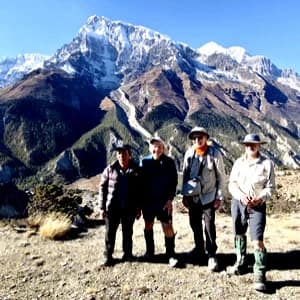
My girlfriend and I did the Annapurna circuit hike in May with Nepal Gateway Trekking. It was awesome!
When organizing the trip we had the...
